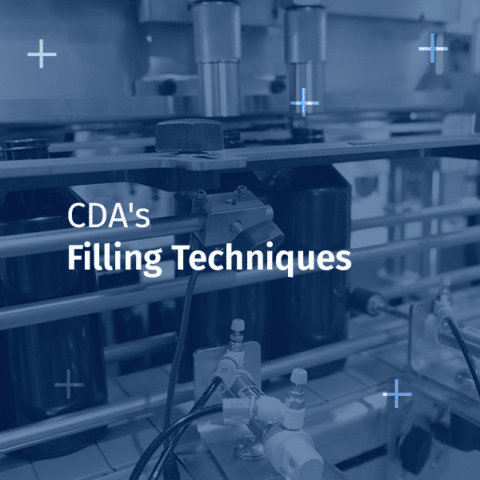In the world of packaging, accurate filling is essential to guarantee product quality and reliability. CDA offers a complete range of semi-automatic and automatic filling machines especially designed for dosing various types of products, whether it is liquid, viscous or pasty.
These technologies include volumetric, flowmetric and weight filling techniques. All three ensure optimum precision.
In this article, we will explore the filling methods outlined above. We will also discuss the advantages and specific features of each of them.
The volumetric dosing method relies on a pump that performs two essential functions: supplying the product and dosing it accurately. Firstly, the pump draws a volume of product from a tank and then delivers it to the desired container. Several types of pumps are available, including :
- peristaltic
- piston pumps
- rotary piston
- gear pumps
- lobe
The advantages of volumetric filling include speed of execution, the ability to handle different types of product and reduced product losses. The technique is also suitable for a wide range of containers, from small bottles to the largest cans.
Here are the pumps that can perform volumetric filling in more details:
This method involves compressing a flexible tube by rotating rollers. The compression of the hose creates a volume, which is then transferred to the container.
The product only comes into contact with the hose, which makes changing the product quick and easy (simply replace the hose).
The system is extremely easy to clean (no need to dismantle the pump to clean it). This is the great advantage of this pump, especially for companies with a large number of products in their range (such as producers of essential oils, e-liquids, cosmetics, etc.).
We recommend the peristaltic pump for dosing fluid products in quantities, between 1 ml and 250 ml, with an accuracy of +/- 0.5% of the volume dosed.
Thanks to a suction mechanism, the product contained in a reservoir is conveyed to the dosing chamber of the piston. In some situations, the piston is fitted with a hopper to simplify the suction process. Once the preset quantity has been reached in the dosing chamber, the piston pushes the product towards the valve and then delivers it to the dosing head.
Our range of piston pumps offers a variety of dosing options, covering a range from 1 to 38 ml, 2 to 100 ml, 5 ml to 250 ml, and so on, up to 1.3 litres. The dosing accuracy is between 0.5% and 1% of the volume dosed (depending on the product and the quantity).
This dosing method is particularly suitable for highly viscous products, such as mustard, ketchup and creams used in cosmetics.
-
- Rotary piston pump
To begin with, the liquid is drawn into the dosing chamber until a specific orifice indicates the stop and the desired quantity. The piston is then rotated, blocking access to a first orifice while freeing a second orifice. The dosed liquid is then dispensed through this second orifice, which is no longer obstructed.
This type of pump is very often used in various sectors of activity, such as industry, chemicals, pharmaceuticals, the food industry, etc. It offers a number of advantages, particularly in terms of hygiene, as it uses no seals, eliminating potential areas for contamination. Maintenance of rotary piston devices is also simplified thanks to the reduced number of wearing parts, resulting in lower maintenance costs. However, it is important to note that the rotary piston may have a poor suction capacity in some situations, which may limit its use in applications requiring a more powerful suction.
The gear pump operates by means of two toothed wheels. These gears are set in motion inside a casing with two ports: one for the inlet and the other for the outlet. The product is housed and transported (between the teeth of the gearwheels and the housing) towards the outlet port. In this way, the quantity dosed is determined by the rotation of the gears.
Our flagship product, the K-Set, is a table-top filler fitted with a gear pump. This machine is specially recommended for filling products with a stringy consistency, such as honey, oil, maple syrup and some e-liquids. Its high dispensing accuracy (+/- 0.5%) makes it ideal for filling containers weighing between 10 grams and 2 kilograms.
- Weight filling
Weight filling is the most accurate dosing method. It is based on measuring the weight of the product during the filling process. This system compensates for variations in container density and ensures unequalled accuracy of the dosed product.
This technique is particularly well suited to high-cost products, such as pharmaceuticals, certain fine chemicals, or expensive ingredients used in the food industry.
The main advantage of weight filling is that it is exceptionally accurate, reducing wastage to a minimum. However, this increased accuracy often results in slower dosing and requires regular calibration to maintain reliability.
- Flowmeter filling
This technique guarantees a constant weight or volume for the quantity of product dosed. Dosing is carried out by means of a flowmeter placed on the filling nozzle (the sensor is in direct contact with the product), and a valve closes automatically once the desired quantity has been reached.
The advantages of this system are as follow :
- High dosing accuracy, with an error margin of around 0.5% for the dosed volume.
- Hygienic approach thanks to the absence of contact between the nozzle and the container, preventing contamination. Ability to dose variable volumes. Several types of flowmeters can be used to dose a liquid, including electromagnetic flowmeters and mass flowmeters.
-
- Electromagnetic flowmeter
This device consists of a tube fitted with two electrodes that generate an electromagnetic field, while a third electrode measures the intensity of this field. Using the difference between these measurements, it is possible to calculate the speed and flow rate of the liquid.
At CDA, we offer filling systems equipped with electromagnetic flowmeters that are compatible with conductive liquids (from 10 μS/cm) or liquids containing hard water. We install these electromagnetic flowmeters to dose volumes ranging from 50 ml to 20 litres, guaranteeing accuracy of between 0.1% and 0.4% of the dosed volume.
-
- Mass flow meter
This device measures the quantity of products (by mass) passing through it. It is able to overcome variations in density, making it suitable for dosing a wide range of products, including non-conductive substances such as oil.
This method is renowned for its hygienic properties, as only two tubes come into contact with the product, reducing the risk of contamination.
It is important to note that this technique can be expensive due to its complexity and the high quality components required to ensure accurate measurement.
We offer fillers fitted with a mass flow meter compatible with dosages of between 50ml and 20L, with an accuracy of between 0.05% and 0.2% of the dosed volume. Olive oil, syrup and cosmetics are all perfectly compatible with this type of filler.
Conclusion
CDA offers a wide range of filling machines. Our machines can be equipped with different dosing systems (volumetric, flowmetric and weight) to meet the specific needs of our customers. Each one of these methods offers distinct advantages in terms of precision, speed, flexibility and cleanability.
Our team of experts is ready to work with you to determine the best solution for your production. You can also send us your products or come directly to our premises so that we can carry out in-depth tests on our test benches. Together, we can decide on the most suitable dosing technique for your entire production.
CDA also offers a range of machines to complement its filling machines. We manufacture screwers, labellers, monoblocks and complete packaging lines.
Do not hesitate to contact our teams to discuss your project.










